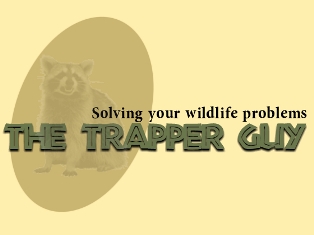
Call
now to solve your nuisance
wildlife problem!
727-710-0373
Serving
Seminole, FL with humane critter
removal 24 hrs a day* and 7 days
a week
Click
here for a free estimate
Seminole used to be forested
and covered in orange groves. It has developed a great deal since I was a kid.
Many of our wild
friends either get pushed out
or become 'urbanized'.
Peoples attics
seem like a cozy nesting place.
Trash cans and pet food are easy
meals and swimming pools are convenient
toilets and bathing spots.
As harmless as
their intentions may be, some
wildlife can
be extremely destructive
to your property. We specialize in Seminole rat control and raccoon removal also squirrel control.
The Trapper Guy
will come out and humanely
remove the live animal
from your property and if possible,
relocate it.
I will fix the damage caused and
make preventative measures so
they won't return.
With proper wildlife
control we can co-exist
with our wild neighbors.
*
24
hour services are for emergencies
only. Live animal in a living
area where safety of the occupants
is in question is considered an
emergency.
|
Seminole
wildlife news
Resident
suspects coyote attack in death of her
cat
By BOB McCLURE
Article published on Wednesday, Jan.
16, 2008
SEMINOLE – A Seminole woman who was
leaving for work and discovered the
remains of her cat in her front yard
believes the pet was killed by a coyote.
Deirdre Cavener, who
lives near the intersection of 102nd
Avenue and Antilles Drive, woke up Jan.
8 between 4 and 5 a.m. and immediately
let her 10-year-old tabby cat out. It
was the cat’s last trip out the front
door.
Later, when a business
partner arrived to pick her up to go
to work, Cavener noticed the carcass
of her cat in the front yard.
“It was the most horrific
thing I’ve ever seen,” said Cavener.
“I live on a quiet cul-de-sac and cats
just hang out in the front yard.”
Cavener said she believes
it was a coyote that killed her cat
because of a recent sighting of a coyote
on 102nd Avenue and the condition of
the cat’s body.
“It (the cat) looked
like an alligator bit it in half,” she
said. “That’s what they (coyotes) do.
Bite and run.”
Dr. Welch Agnew, director
of Pinellas County Animal Services,
said it is highly possible the cat was
killed by a coyote.
“There are coyotes around
Walsingham Park or it could have been
dogs,” Welch said. “Dogs generally leave
the carcass after they kill an animal
because they have a food source. Coyotes
usually take the dead prey with them
to eat.”
Welch said the best
defense against coyotes is to keep small
pets inside.
“It’s a terrible thing
but there are coyotes running around,”
Agnew said. “All you can do is keep
them inside. Fencing is helpful.”
Agnew also noted that
coyotes have a natural fear of humans
and should not ever be fed.
According to the Florida
Fish and Wildlife Conservation Commission,
coyotes are a member of the dog family
and are similar in appearance to a medium-size
shepherd at 20 to 30 pounds.
They were first seen
in Florida about 40 years ago and in
recent years they have been spotted
in all 67 Florida counties.
Their favorite foods
include small domestic dogs, cats, rabbits,
raccoons, foxes, birds, eggs from sea
turtles, gopher tortoises, garbage,
watermelons and cantaloupes.
Coyotes, which generally
are most active at sunrise or sunset,
seldom are a threat to humans. Most
documented cases involve scratches and
bites to farmers trying to chase the
animals during an attack on other livestock.
Also, coyotes generally
hunt alone or in pairs. Occasionally
they travel in family units. They can
be legally hunted in Florida all year
long with guns, dogs, live traps and
snares.
Those that suspect they
have located a coyote den should contact
Pinellas County Animal Services at 582-2600
or the FWC at 863-648-3200.
|